Research Article - (2023) Volume 12, Issue 1
Introducton: The mandible is the most commonly fractured facial bone following maxillofacial trauma. The aetiology and pattern of mandibular fractures vary geographically. Contributory factors are motorcycle use, reckless driving, alcohol and substance abuse and bad roads. Road traffic legislation, use of seat belts and personal protective wear, have been shown to reduce the incidence of accidents. The use of motorcycles for commercial transport was banned in Enugu state in 2012.
Aims & Objectives: To show the change in aetiology and incidence of mandibular fractures since this legislative act was instituted in the state.
Materials & Methods: Patients’ records with mandibular fractures between 2012 and 2017 were evaluated. Age, sex, aetiology of fracture, pattern of fracture, time of year and treatment modality used were considered.
Results: A total of 98 patients were studied. There were 60 patients in the first 5 years and 38 patients in the second 6 years. The demographics between both groups were similar, with a greater percentage of males (73.3% males and 26.7% females in the first five years and 86.8% males and 13.2% females in the second six years). Majority of the fractures occurred in young males between the ages of 21 and 30 in both time frames studied.
Conclusion: The incidence of mandibular fractures in our study showed a steady decline from 2012 when motorcycles were banned and traffic laws strictly enforced in Enugu State. This study shows the positive impact of legislation on health and disease.
Mandibular fracture • Pattern • Incidence • Nigeria • Review
The mandible is the most commonly fractured facial bone following maxillofacial trauma [1-4]. The aetiology and pattern of mandibular fractures vary according to geographic location [5,6]. Most studies in developing countries suggest that the commonest cause of these fractures is road traffic crashes, as against assault and interpersonal violence in more developed climes. Contributory to these road traffic crashes are motorcycle use, reckless driving, alcohol and substance abuse and bad roads [5]. Road traffic legislation, use of seat belts and personal protective wear, have been shown to reduce the incidence of these accidents. The use of motorcycles as a commercial mode of transport was banned in Enugu state in 2012, with strict enforcement of road traffic rules. There was no new tertiary hospital catering for maxillofacial injuries that opened in the period of the study, nor was there a decline in the number of consultants or doctors in the National orthopaedic hospital Enugu in the period.
The aim of this paper is to show that the aetiology and incidence of mandibular fractures has changed since this legislative act was instituted in the state.
Ethical approval for this retrospective study was obtained from the National Orthopaedic Hospital Enugu (NOHE) ethical committee. The records of all patients who sustained mandibular fractures between 2007 and 2017 were evaluated. Age, sex, aetiology of fracture, pattern of fracture, time of year and treatment modality used were some of the factors considered. Patients were divided into 6 age groups in units of 10 starting from 10-20. Data were entered directly into a spreadsheet using SPSS version 25 for analysis.
A total of 98 patients were retrospectively studied from January 2007 to December 2017. The demographics between both groups were similar, with a greater percentage of males (73.3% males and 26.7% females in the first 5 years and 86.8% males and 13.2% females in the second 6 years). We noticed the bulk of the fractures occurred in young males between the ages of 21 and 30 (Tables 1-4).
Table 1. Age distribution of patients 2007-2011 (Mean age: 28.07 ± 9.19).
| Age group | Male | Female | All | p-value |
|---|---|---|---|---|
| 10–20 | 8 (13.3%) | 1 (1.7%) | 9 (15.0%) | 0.502 |
| 21–30 | 24 (40%) | 12 (20%) | 36 (60%) | |
| 31–40 | 6 (10%) | 1 (1.7%) | 7 (11.7%) | |
| 41 –50 | 4 (6.7%) | 2 (3.3%) | 6 (10%) | |
| 51–60 | 2 (3.3%) | 0 (0%) | 2 (3.3%) | |
| Total | 44 (73.3%) | 16 (26.7%) | 60 (100%) |
Table 2. Age Distribution of Patients 2012- 2017.
| Age | Frequency | Percentages |
|---|---|---|
| 20 | 9 | 23.7 |
| 21-30 | 20 | 52.6 |
| 31-40 | 6 | 15.8 |
| 41-50 | 1 | 2.6 |
| 51-60 | 1 | 2.6 |
| 61-70 | 1 | 2.6 |
| Total | 38 | 100 |
Table 3. Aetiology of injuries 2007-2011.
Mechanism |
Male | Female | Total | p-value |
|---|---|---|---|---|
Motorcycle |
25 (48.1%) | 3 (5.8%) | 28 (53.8%) | 0.034 |
Motor vehicle |
10 (19.2%) | 10 (19.2%) | 20 (38.5%) | |
Fall from height |
0 (0%) | 1 (1.9%) | 1 (1.9%) | |
Gunshot |
0 (0%) | 1 (1.9%) | 1 (1.9%) | |
Assault |
1 (1.9%) | 1 (1.9%) | 2 (3.8%) |
Table 4. Aetiology of injuries 2012-2017 (RTA- Road Traffic Accident, MVA- Motor Vehicle Accident)
| Mechanism of injury | Frequency | Percentages |
|---|---|---|
| Motorcycle RTA | 16 | 42.1 |
| Fall | 3 | 7.9 |
| Assault | 3 | 7.9 |
| MVA | 11 | 28.9 |
| Gunshot | 3 | 7.9 |
| Tricycle RTA | 2 | 5.3 |
| Total | 38 | 100 |
Before the ban, most of the accidents (65%) occurred within Enugu metropolis, a direct opposite of the situation found after the ban (Figures 1 and 2).
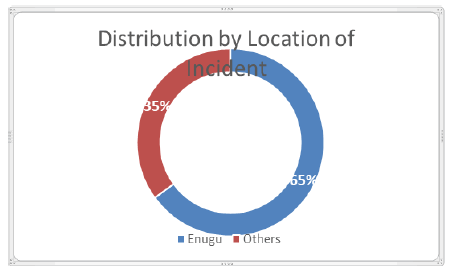
Figure 1: Geographic location where incident occurred 2007- 2011.
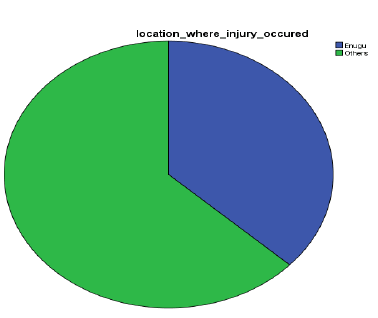
Figure 2: ldacr-12-1-22322-g002
Most of the injuries occurred following Road Traffic Accidents (RTAs). Figure 3 shows a comparison of these mechanisms of injury in the 11 years studied, RTAs from motorcycle accidents caused the most fractures but the numbers were much less after the ban than before. We also noted in our series, that most patients had parasymphyseal fractures, 40.4% in the first five years. In the second six years however, combined fractures were more common (Tables 5-8).
Table 5. Site of fracture 2007-2011.
| Site of fracture | Male | Female | Total | p-value |
|---|---|---|---|---|
| Symphyseal | 5 (9.6%) | 2 (3.8%) | 7 (13.5%) | 0.507 |
| Parasymphyseal | 13 (25%) | 8 (15.4%) | 21 (40.4%) | |
| Angle | 4 (7.7%) | 0 (0%) | 4 (7.7%) | |
| Body | 3 (5.8%) | 3 (5.8%) | 6 (11.6%) | |
| Others | 11 (21%) | 3 (5.8%) | 14 (26.8%) |
Table 6. site of fracture 2012-2017.
| Site of fracture | Frequency | Percentages |
|---|---|---|
| Symphyseal | 3 | 7.9 |
| Parasymphyseal | 12 | 31.6 |
| Body | 5 | 13.2 |
| Angle | 1 | 2.6 |
| Combined | 16 | 42.1 |
| Missing value | 1 | 2.6 |
| Total | 37 | 97.4 |
Table 7. Type of intervention received 2007-2011.
| Treatment | Male | Female | Total | p-value |
|---|---|---|---|---|
| MMF | 39 (65%) | 14 (23.3%) | 53 (88.3%) | 0.332 |
| ORIF | 3 (5%) | 0 (0%) | 3 (5%) | |
| Others | 2 (3.3%) | 2 (3.3%) | 4 (6.6%) |
Table 8. Type of intervention received 2012-2017.
|
Frequency | Percent | Valid Percent | Cumulative Percent |
|---|---|---|---|---|
| MMF | 29 | 76.3 | 76.3 | 76.3 |
| ORIF with plates and screws | 9 | 23.7 | 23.7 | 100 |
| Total | 38 | 100 | 100 |
Complications recorded were malunion and TMJ ankylosis. The incidence of mandibular fractures over these 11 years is shown (Figures 3-5).
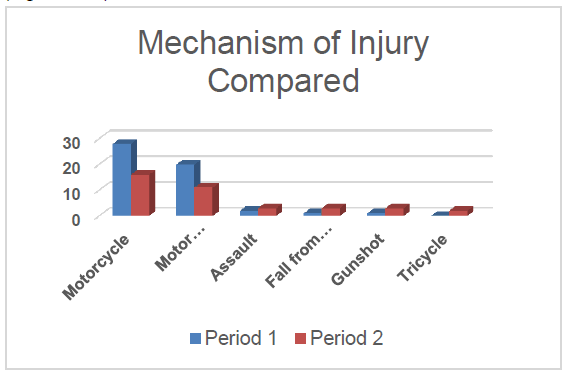
Figure 3: Mechanism of injury in 2007-2017
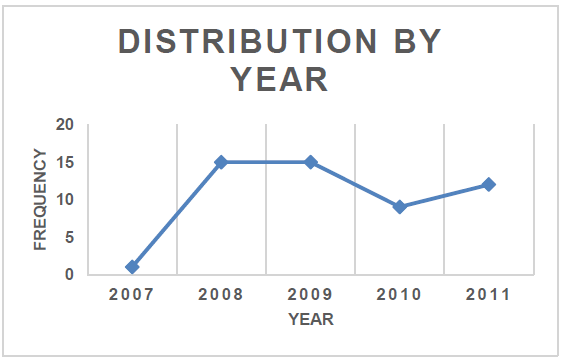
Figure 4: Incidence of mandibular fractures 2007-2011.
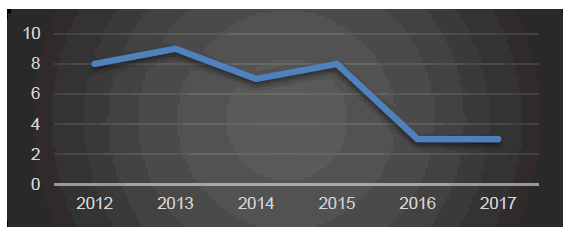
Figure 5: Incidence of mandibular fractures 2012-2017.
The aetiology and incidence of mandibular fractures varies according to location, cultural, socioeconomic and environmental factors [4-6]. This study was carried out at NOHE which is an orthopaedic and plastic surgery centre that caters to a significant number of trauma patients in Enugu and environs. It’s a major referral centre for patients in and around Enugu. Mandibular fractures that present are treated by the plastic surgery division.
Our study revealed that most of the mandibular fractures occurred in the 3rd decade of life with a male preponderance. People in this age group are more active socially, in business, high speed chase and other activities that make them prone to these injuries. This is in keeping with findings by Subodh et al amongst others [7-10]. Our youngest patient was 10 years and the oldest was 70 years.
Motorcycle accidents were the commonest cause of mandibular fractures in both time frames studied in our series, accounting for 53.8% in the first five years and 42.1% of all injuries in the second six years. This correlates with findings by Obimakinde et al [6-12]. In more developed countries however, interpersonal violence and motor vehicle accidents ranked higher as aetiological factors for mandibular fractures [13].
The advent of motorcycles as a means of transport in Nigeria has increased the incidence of RTAs. Most of the riders are young uneducated youths, more likely to abuse substance. These motorcycles can meander through dangerously narrow and windy alcoves. The lack of external covering as seen in cars, no airbags and the flagrant disregard for use of protective gear and traffic rules increases the chances of injuries from this mechanism [6-13].
Since 2012 when the Enugu State government banned the use of motorcycles in the metropolis, the number of patients with mandibular fractures has declined. An independent sample t test was used in comparing the mean number of cases between the time frames before and after the ban. There is a significantly higher number of cases in the five years before the ban (p=0.044). There was no new tertiary hospital catering for maxillofacial injuries that opened in the period of the study, nor was there a decline in the number of consultants or doctors in the National orthopaedic hospital Enugu in the study period. We therefore attribute the decline in patients seen to the effects of the legislation [14].
The major cause of mandibular fractures still remains motorcycle accidents. Before the ban, majority of the patients presenting for treatment had their injuries occur within the Enugu metropolis. It is interesting to note that after the ban, 63.2% came from outside Enugu and only 36.8% occurred within Enugu . Tricycles which replaced motorcycles were the least cause of mandibular fractures (5.3%) in this series. The most common cause of injury within the Enugu metropolis was MVAs. This pattern is found in more developed places where motorcycle use is not as rampant as seen in Nigeria and most other developing countries.
Our study showed that injuries occurred more frequently in the month of January, April, September and December in the 5 years before the ban but in the month of February after the ban. This is at variance with findings by Kirk et al and Morris et al where the highest incidence of fractures was found in June, July, August and least in December, January and February. They attributed this to better weather in the latter months encouraging more outdoor activities. Findings from the first five years before the ban however are in keeping with those by Ugboko et al who found an increased incidence in December, January, April and May which they attributed to the end of the fasting period with people trying to make up for their dietary restrictions thus indulging in more alcohol consumption.
The incidence of mandibular fractures in our study showed a steady decline from 2012 when motorcycles were banned and traffic laws strictly enforced in Enugu State. This study shows the positive impact of legislation on health and disease.
The authors declare no conflict of interest and received no financial support for this work.
Citation: Ehighibe, AP., et al. Pattern and Incidence of Mandibular Fractures in Enugu and Environs- an 11 Year Review. Reconstr Surg Anaplastol. 2023, 12(1), 001-004.
Received: 07-Jan-2023, Manuscript No. ACR-23-22322; Editor assigned: 09-Jan-2023, Pre QC No. ACR-23-22322 (PQ); Reviewed: 19-Jan-2023, QC No. ACR-23- 22322 (Q); Revised: 23-Jan-2023, Manuscript No. ACR-23-22322 (R); Published: 30-Jan-2023, DOI: 10.37532/acr.23.12.1.001-010
Copyright: © 2023 Ehighibe, AP. This is an open-access article distributed under the terms of the Creative Commons Attribution License CC-BY, which permits unrestricted use, distribution, and reproduction in any medium, provided the original author and source are credited.